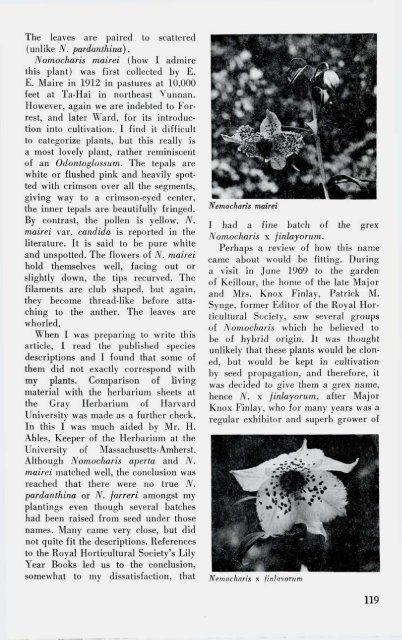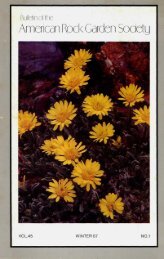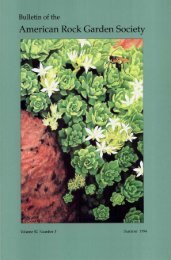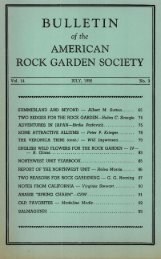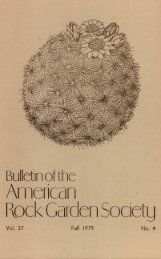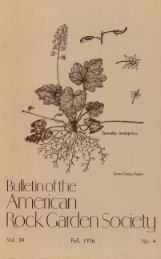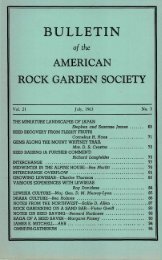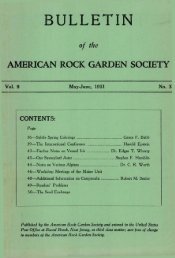Bulletin - Summer 1979 - North American Rock Garden Society
Bulletin - Summer 1979 - North American Rock Garden Society
Bulletin - Summer 1979 - North American Rock Garden Society
Create successful ePaper yourself
Turn your PDF publications into a flip-book with our unique Google optimized e-Paper software.
The leaves are paired to scattered(unlike N. pardanthina).Nomocharis mairei (how I admirethis plant) was first collected by E.E. Maire in 1912 in pastures at 10,000feet at Ta-Hai in northeast Yunnan.However, again we are indebted to Forrest,and later Ward, for its introductioninto cultivation. I find it difficultto categorize plants, but this really isa most lovely plant, rather reminiscentof an Odontoglossum. The tepals arewhite or flushed pink and heavily spottedwith crimson over all the segments,giving way to a crimson-eyed center,the inner tepals are beautifully fringed.By contrast, the pollen is yellow. N.mairei var. Candida is reported in theliterature. It is said to be pure whiteand unspotted. The flowers of N. maireihold themselves well, facing out orslightly down, the tips recurved. Thefilaments are club shaped, but again,they become thread-like before attachingto the anther. The leaves arewhorled.When I was preparing to write thisarticle, I read the published speciesdescriptions and I found that some ofthem did not exactly correspond withmy plants. Comparison of livingmaterial with the herbarium sheets atthe Gray Herbarium of HarvardUniversity was made as a further check.In this I was much aided by Mr. H.Ahles, Keeper of the Herbarium at theUniversity of Massachusetts-Amherst.Although Nomocharis aperta and N.mairei matched well, the conclusion wasreached that there were no true N.pardanthina or N. farreri amongst myplantings even though several batcheshad been raised from seed under thosenames. Many came very close, but didnot quite fit the descriptions. Referencesto the Royal Horticultural <strong>Society</strong>'s LilyYear Books led us to the conclusion,somewhat to my dissatisfaction, thatNemocharis maireiI had a fine batch of the grexNomocharis x finlajorum.Perhaps a review of how this namecame about would be fitting. Duringa visit in June 1969 to the gardenof Keillour, the home of the late Majorand Mrs. Knox Finlay, Patrick M.Synge, former Editor of the Royal Horticultural<strong>Society</strong>, saw several groupsof Nomocharis which he believed tobe of hybrid origin. It was thoughtunlikely that these plants would be cloned,but would be kept in cultivationby seed propagation, and therefore, itwas decided to give them a grex name,hence N. x finlayorum, after MajorKnox Finlay, who for many years was aregular exhibitor and superb grower ofNemocharis x finlavorum119


